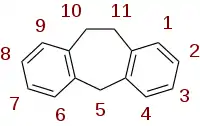 | |
 | |
| Names | |
|---|---|
| Preferred IUPAC name
10,11-Dihydro-5H-dibenzo[a,d][7]annulene | |
| Other names
10,11-dihydro-5H-dibenzo[a,d]cycloheptene | |
| Identifiers | |
3D model (JSmol) |
|
| ChemSpider | |
| ECHA InfoCard | 100.011.482 |
PubChem CID |
|
| UNII | |
CompTox Dashboard (EPA) |
|
| |
| |
| Properties | |
| C15H14 | |
| Molar mass | 194.27 g/mol |
Except where otherwise noted, data are given for materials in their standard state (at 25 °C [77 °F], 100 kPa).
Infobox references | |
Preferably called dibenzosuberane (other less common names are Dibenzocycloheptene and dibenzocycloheptadiene) is a tricyclic chemical compound featuring two benzene rings bound to a cycloheptene group. It is an occasional motif in synthetic organic chemistry.[1] Various tricyclic antidepressants (TCAs) contain the dibenzocycloheptene moiety in their chemical structures, including amineptine, amitriptyline, amitriptylinoxide, butriptyline, demexiptiline, nortriptyline, noxiptiline, and protriptyline. Cyclobenzaprine, a skeletal muscle relaxant, also contains this functional group.
Numbering System

Dibenzosuberane numbering system
See also
External links
- Dibenzocycloheptenes at the U.S. National Library of Medicine Medical Subject Headings (MeSH)
References
- ↑ Chen, Chien-Tien; Chou, Y-Chen (2000). "C2-Symmetric Dibenzosuberane-Based Helicenes as Potential Chirochromic Optical Switches". Journal of the American Chemical Society. 122 (32): 7662–7672. doi:10.1021/ja993297d.
This article is issued from Wikipedia. The text is licensed under Creative Commons - Attribution - Sharealike. Additional terms may apply for the media files.